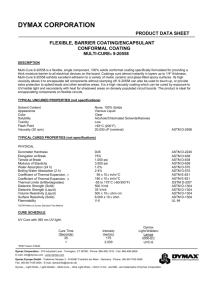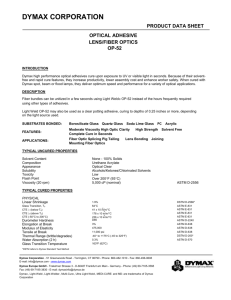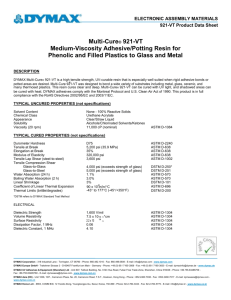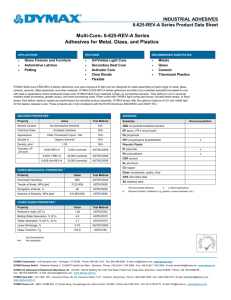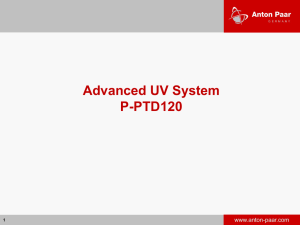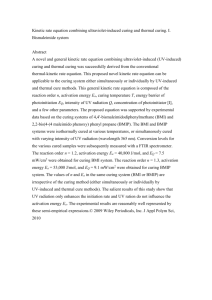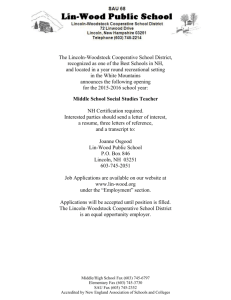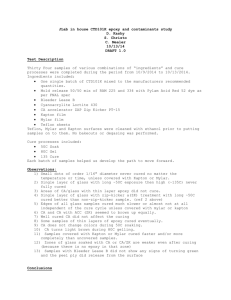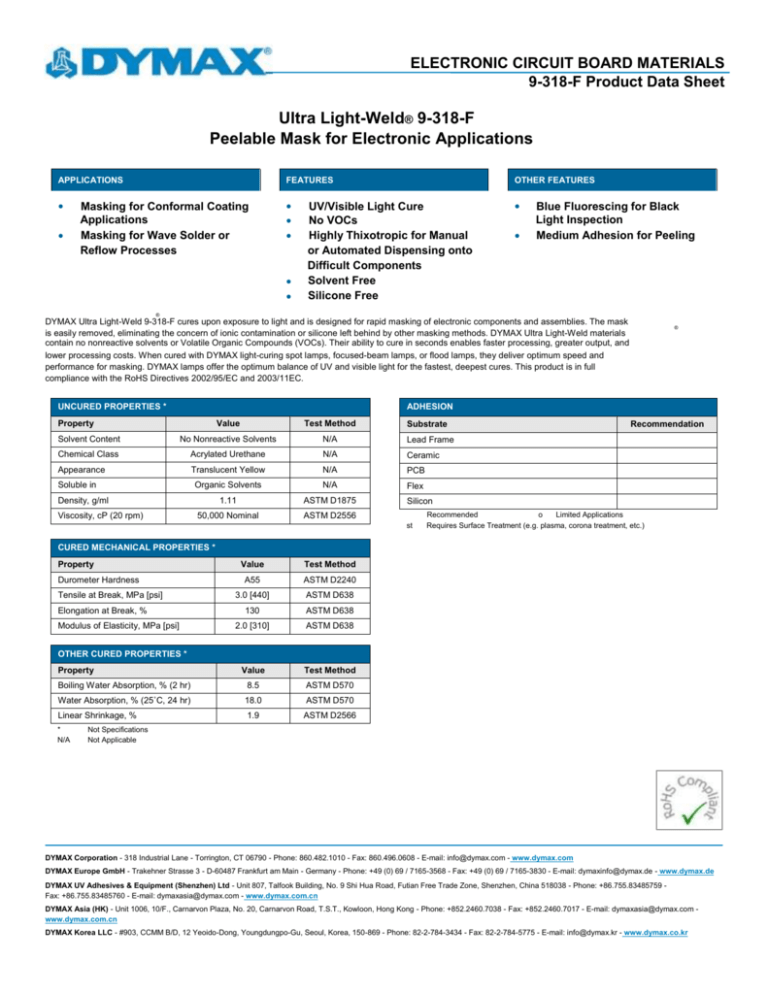
ELECTRONIC CIRCUIT BOARD MATERIALS
9-318-F Product Data Sheet
Ultra Light-Weld® 9-318-F
Peelable Mask for Electronic Applications
APPLICATIONS
FEATURES
OTHER FEATURES
Masking for Conformal Coating
Applications
Masking for Wave Solder or
Reflow Processes
UV/Visible Light Cure
No VOCs
Highly Thixotropic for Manual
or Automated Dispensing onto
Difficult Components
Solvent Free
Silicone Free
Blue Fluorescing for Black
Light Inspection
Medium Adhesion for Peeling
®
DYMAX Ultra Light-Weld 9-318-F cures upon exposure to light and is designed for rapid masking of electronic components and assemblies. The mask
is easily removed, eliminating the concern of ionic contamination or silicone left behind by other masking methods. DYMAX Ultra Light-Weld materials
contain no nonreactive solvents or Volatile Organic Compounds (VOCs). Their ability to cure in seconds enables faster processing, greater output, and
lower processing costs. When cured with DYMAX light-curing spot lamps, focused-beam lamps, or flood lamps, they deliver optimum speed and
performance for masking. DYMAX lamps offer the optimum balance of UV and visible light for the fastest, deepest cures. This product is in full
compliance with the RoHS Directives 2002/95/EC and 2003/11EC.
UNCURED PROPERTIES *
®
ADHESION
Property
Value
Test Method
Solvent Content
No Nonreactive Solvents
N/A
Lead Frame
Chemical Class
Acrylated Urethane
N/A
Ceramic
Appearance
Translucent Yellow
N/A
PCB
Organic Solvents
N/A
Flex
1.11
ASTM D1875
50,000 Nominal
ASTM D2556
Soluble in
Density, g/ml
Viscosity, cP (20 rpm)
Substrate
Recommendation
Silicon
st
Limited Applications
Recommended
o
Requires Surface Treatment (e.g. plasma, corona treatment, etc.)
CURED MECHANICAL PROPERTIES *
Property
Durometer Hardness
Tensile at Break, MPa [psi]
Elongation at Break, %
Modulus of Elasticity, MPa [psi]
Value
Test Method
A55
ASTM D2240
3.0 [440]
ASTM D638
130
ASTM D638
2.0 [310]
ASTM D638
OTHER CURED PROPERTIES *
Property
Value
Test Method
Boiling Water Absorption, % (2 hr)
8.5
ASTM D570
Water Absorption, % (25˚C, 24 hr)
18.0
ASTM D570
Linear Shrinkage, %
1.9
ASTM D2566
*
N/A
Not Specifications
Not Applicable
DYMAX Corporation - 318 Industrial Lane - Torrington, CT 06790 - Phone: 860.482.1010 - Fax: 860.496.0608 - E-mail: info@dymax.com - www.dymax.com
DYMAX Europe GmbH - Trakehner Strasse 3 - D-60487 Frankfurt am Main - Germany - Phone: +49 (0) 69 / 7165-3568 - Fax: +49 (0) 69 / 7165-3830 - E-mail: dymaxinfo@dymax.de - www.dymax.de
DYMAX UV Adhesives & Equipment (Shenzhen) Ltd - Unit 807, Talfook Building, No. 9 Shi Hua Road, Futian Free Trade Zone, Shenzhen, China 518038 - Phone: +86.755.83485759 Fax: +86.755.83485760 - E-mail: dymaxasia@dymax.com - www.dymax.com.cn
DYMAX Asia (HK) - Unit 1006, 10/F., Carnarvon Plaza, No. 20, Carnarvon Road, T.S.T., Kowloon, Hong Kong - Phone: +852.2460.7038 - Fax: +852.2460.7017 - E-mail: dymaxasia@dymax.com www.dymax.com.cn
DYMAX Korea LLC - #903, CCMM B/D, 12 Yeoido-Dong, Youngdungpo-Gu, Seoul, Korea, 150-869 - Phone: 82-2-784-3434 - Fax: 82-2-784-5775 - E-mail: info@dymax.kr - www.dymax.co.kr
ELECTRONIC CIRCUIT BOARD MATERIALS
9-318-F Product Data Sheet
CURING GUIDELINES
DEPTH OF CURE
Fixture time is defined as the time to develop a shear strength of
0.1
N/mm2 [10 psi] between glass slides. Actual cure time typically is 3 to
5 times fixture time.
The graphs below show the increase in depth of cure as a function of
exposure time with two different lamps at different intensities.
A 9.5 mm [0.37 in] diameter specimen was cured in a polypropylene mold
and cooled to room temperature. It was then released from the mold and
the cure depth was measured.
Fixture Time
or Belt Speed
1 Sec
DYMAX Curing System (Intensity)
5000-EC (200 mW/cm )
2A
®
BlueWave 75 (5.0 W/cm )
®
BlueWave 200 (10 W/cm )
Depth of Cure
5000-EC (200 mW/cm 2)
1 Sec
2A
0.2 Sec
2A
UVCS Conveyor with one 5000-EC (200 mW/cm )
UVCS Conveyor with Fusion F300S (2.5 W/cm )
9
0.1 Sec
2C
2C
1.5 m/min
[5 ft/min]
7.3 m/min
[24 ft/min]
A
Intensity was measured over the UVA range (320-395 nm) using a
DYMAX ACCU-CAL™ 50 Radiometer.
B
Curing through light-blocking substrates may require longer cure times
if they obstruct wavelengths used for light curing (320-400 nm for UV
light curing, 320-450 nm for UV/Visible light curing). These fixture
times/belt speeds are typical for curing thin films through 100% lighttransmitting substrates.
At 53 mm [2.1 in] focal distance. Maximum speed of conveyor is
8.2 m/min [27 ft/min]. Intensity was measured over the UVA range
(320-395 nm) using the DYMAX ACCU-CAL™ 100 Radiometer.
C
B
Full cure is best determined empirically by curing at different times and
intensities, and measuring the corresponding change in cured properties
such as tackiness, adhesion, hardness, etc. Full cure is defined as the
point at which more light exposure no longer improves cured properties.
Higher intensities or longer cures (up to 5x) generally will not degrade
DYMAX light-curable materials.
6
Depth (mm)
2000-EC (50 mW/cm )
2A
3
0
0
6
12
18
24
Time (seconds)
Depth of Cure
BlueWave® 200 (10 W/cm 2)
16
Depth (mm)
12
DYMAX recommends that customers employ a safety factor by curing
longer and/or at higher intensities than required for full cure. Although
DYMAX Applications Engineering can provide technical support and
assist with process development, each customer ultimately must
determine and qualify the appropriate curing parameters required for
their unique application.
8
4
0
0
1
2
3
4
Time (seconds)
DYMAX Corporation - 318 Industrial Lane - Torrington, CT 06790 - Phone: 860.482.1010 - Fax: 860.496.0608 - E-mail: info@dymax.com - www.dymax.com
DYMAX Europe GmbH - Trakehner Strasse 3 - D-60487 Frankfurt am Main - Germany - Phone: +49 (0) 69 / 7165-3568 - Fax: +49 (0) 69 / 7165-3830 - E-mail: dymaxinfo@dymax.de - www.dymax.de
DYMAX UV Adhesives & Equipment (Shenzhen) Ltd - Unit 807, Talfook Building, No. 9 Shi Hua Road, Futian Free Trade Zone, Shenzhen, China 518038 - Phone: +86.755.83485759 Fax: +86.755.83485760 - E-mail: dymaxasia@dymax.com - www.dymax.com.cn
DYMAX Asia (HK) - Unit 1006, 10/F., Carnarvon Plaza, No. 20, Carnarvon Road, T.S.T., Kowloon, Hong Kong - Phone: +852.2460.7038 - Fax: +852.2460.7017 - E-mail: dymaxasia@dymax.com www.dymax.com.cn
DYMAX Korea LLC - #903, CCMM B/D, 12 Yeoido-Dong, Youngdungpo-Gu, Seoul, Korea, 150-869 - Phone: 82-2-784-3434 - Fax: 82-2-784-5775 - E-mail: info@dymax.kr - www.dymax.co.kr
ELECTRONIC CIRCUIT BOARD MATERIALS
9-318-F Product Data Sheet
OPTIMIZING PERFORMANCE AND HANDLING
PERFORMANCE AFTER TEMPERATURE EXPOSURE
1.
This product cures with exposure to UV and visible light. Exposure
to ambient and artificial light should be kept to a minimum before
curing. Dispensing components including needles and fluid lines
should be 100% light blocking, not just UV blocking.
2.
All surfaces in contact with the material should be clean and free
from flux residue, grease, mold release, or other contaminants
prior to dispensing the material.
Light-cured DYMAX materials typically have a lower thermal limit of
-54˚C [-65˚F] and an upper limit of 150˚C [300˚F]. Many DYMAX products
can withstand temperatures outside of this range for short periods of time,
including typical wave solder processes and reflow profiles. Please contact
DYMAX Applications Engineering for assistance.
3.
Cure speed is dependent upon many variables, including lamp
intensity, distance from the light source, required depth of cure,
thickness, and percent light transmission of components between
the material and light source.
4.
Oxygen in the atmosphere may inhibit surface cure. Surfaces
exposed to air may require high intensity (>100 mW/cm2) UV light
to produce a dry surface cure. Flooding the curing area with an
inert gas, such as nitrogen, can also reduce the affects of oxygen
inhibition.
5.
Parts should be allowed to cool after cure before testing and
subjecting to any loads or electrical testing.
6.
In rare cases, stress cracking may occur in assembled parts.
Three options may be explored to eliminate this problem. One
option is to heat anneal the parts to remove molded-in stresses. A
second option is to open any gap between mating parts to reduce
stress caused by an interference fit. The third option is to minimize
the amount of time the liquid material remains in contact with the
substrate(s) prior to curing.
STORAGE AND SHELF LIFE
Store the material in a cool, dark place when not in use. Do not expose to
light. This product may polymerize upon prolonged exposure to ambient
and artificial light. Keep covered when not in use. This material has a
minimum 12-month shelf life from date of shipment, unless otherwise
specified, when stored between 10˚C [50˚F] and 32˚C [90˚F] in the original,
unopened container.
GENERAL INFORMATION
This product is intended for industrial use only. Keep out of the reach of
children. Avoid breathing vapors. Avoid contact with skin, eyes, and
clothing. Wear impervious gloves. Repeated or continuous skin contact
with uncured material may cause irritation. Remove material from skin with
soap and water. Never use organic solvents to remove material from skin
and eyes. For more information on the safe handling of this material,
please refer to the Material Safety Data Sheet before use.
RECOMMENDED DYMAX LITERATURE
LIT010A
Guide to Selecting and Using UV Light-Curing Systems
Light curing generally produces some heat. If necessary, cooling
fans can be placed in the curing area to reduce the heating effect
on components.
LIT019
Light-Curable Materials for Electronic Assembly
LIT077
Chemical Safety
LIT133
UV Light-Curing System Safety Considerations
At the point of curing, an air exhaust system is recommended to
dissipate any heat and vapors formed during the curing process.
LIT159
ACCU-CAL™ 50 Radiometer
LIT196
ACCU-CAL™ 100 Radiometer
DISPENSING THE MATERIAL
LIT206
Flood and Focused-Beam UV Light-Curing Systems
This material may be dispensed with a variety of manual and automatic
applicators or other equipment as required. Questions relating to
dispensing and curing systems for specific applications should be
referred to DYMAX Applications Engineering.
LIT218
BlueWave 200 UV Light-Curing Spot Lamp
LIT238
BlueWave 75 UV Light-Curing Spot Lamp
7.
8.
®
®
Literature is available at www.dymax.com, or by calling any DYMAX
location
CLEAN UP
Uncured material may be removed from dispensing components and
parts with organic solvents. Cured material will be impervious to many
solvents and difficult to remove. Clean up of cured material may require
mechanical methods of removal.
© 1997-2010 DYMAX Corporation. All rights reserved. All trademarks in this guide, except where noted, are the property of, or used under license by DYMAX Corporation, U.S.A.
The data contained in this bulletin is of a general nature and is based on laboratory test conditions. DYMAX does not warrant the data contained in this bulletin. Any warranty applicable to the product, its
application and use is strictly limited to that contained in DYMAX’s standard Conditions of Sale. DYMAX does not assume responsibility for test or performance results obtained by users. It is the user’s responsibility to
determine the suitability for the product application and purposes and the suitability for use in the user’s intended manufacturing apparatus and methods. The user should adopt such precautions and use guidelines as
may be reasonably advisable or necessary for the protection of property and persons. Nothing in this bulletin shall act as a representation that the product use or application will not infringe a patent owned by someone
other than DYMAX or act as a grant of license under any DYMAX Corporation Patent. DYMAX recommends that each user adequately test its proposed use and application before actual repetitive use, using the data
contained in this bulletin as a general guide.
Technical Data Collection Prior to 1997
Rev. 08/18/2010
DYMAX Corporation - 318 Industrial Lane - Torrington, CT 06790 - Phone: 860.482.1010 - Fax: 860.496.0608 - E-mail: info@dymax.com - www.dymax.com
DYMAX Europe GmbH - Trakehner Strasse 3 - D-60487 Frankfurt am Main - Germany - Phone: +49 (0) 69 / 7165-3568 - Fax: +49 (0) 69 / 7165-3830 - E-mail: dymaxinfo@dymax.de - www.dymax.de
DYMAX UV Adhesives & Equipment (Shenzhen) Ltd - Unit 807, Talfook Building, No. 9 Shi Hua Road, Futian Free Trade Zone, Shenzhen, China 518038 - Phone: +86.755.83485759 Fax: +86.755.83485760 - E-mail: dymaxasia@dymax.com - www.dymax.com.cn
DYMAX Asia (HK) - Unit 1006, 10/F., Carnarvon Plaza, No. 20, Carnarvon Road, T.S.T., Kowloon, Hong Kong - Phone: +852.2460.7038 - Fax: +852.2460.7017 - E-mail: dymaxasia@dymax.com www.dymax.com.cn
DYMAX Korea LLC - #903, CCMM B/D, 12 Yeoido-Dong, Youngdungpo-Gu, Seoul, Korea, 150-869 - Phone: 82-2-784-3434 - Fax: 82-2-784-5775 - E-mail: info@dymax.kr - www.dymax.co.kr
感谢您试用AnyBizSoft PDF to Word。
试用版仅能转换5页文档。
要转换全部文档,免费获取注册码请访问
http://www.anypdftools.com/pdf-to-word-cn.html

